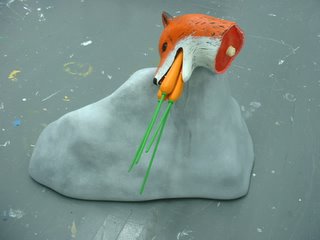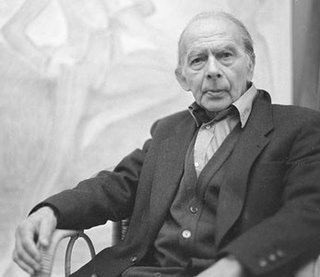
This past Thursday, Dec. 8th I attended an event at PS1 celebrating the recent “visual issue” of The Believer. Here is a cross-section of a review I started writing:
Leading up to Matthew Ronay and Brandon Stosuy’s live “interview,” Eric Fischl extemporized on the “death of painting,” beginning with the observation: Vincent Van Gogh cut off his ear and made a self-portrait of himself afterwards and the painting was considered art; approximately a century later Chris Burden had an assistant shoot him in the arm with a rifle and this action, and not its “documents” and reliquaries, was instead considered the work of art. Throughout his presentation, Fischl proceeded largely by surveying particular sculptural and painted works and considering an evolution of painting and sculpture towards their dematerialization (or “death,” as he referred to it) and works after. Where I thought Fischl was connecting some interesting dots, he seemed careful or unwilling to draw conclusions during his talk, putting forward instead questions and conjectures that “interested” him.
Fischl concluded his presentation with some remarks about the current “state of art” (and NYC-based visual art in particular) post 9/11. His moralizing finale was both traumatic and pedestrian: artists failed to respond adequately to 9/11, to take “action” through their work, and this failure represents a "paradigmatic shift" in art’s claim to a moral and/or political efficacy. In response to Fischl’s conclusion the artist and self-proclaimed "amateur materialist” sitting beside me, Eliza Newman-Saul, conveyed a more radical conclusion, one that may go productively against the grain (and the refrains) of ongoing assessments of that “disaster”: that merely siting a “paradigmatic change” after 9/11 obviates the critical imperative to investigate the event’s historicity, and History itself as both a synchronous and diachronous procession. Or, in other words, that there is in fact no “paradigmatic change” nor necessarily an “event character” about 9/11 in its relation to “art,” but only, perhaps, what Barrett Watten calls "bad history": history traumatically cathected by the dialectical “blindspots" and "traumatic kernels" of a truth content neither arbitrarily unprecedented or absolutely discontinuous.
Where Fischl presented a moral response to art after 9/11, coincidentally Ronay / Stosuy presented what I took to be an ethical or ethological one. So much depends upon the distinction. Beginning with clips of football injuries in which one could see knees fully dislocated from their joints and legs hanging from their ligaments, Ronay proceeded mainly to address his own work after 9/11. His conclusion: artists tended to “internalize” the event and in turn responded by making work around problems of “death,” “sexuality,” and “the body”. As Ronay admitted, these are problems of “existential” concern; but they are also “ethological” ones insofar as they investigate “what a body can do” (Spinoza) and what one is capable of believing in (Deleuze’s Philosophy should give us something in which to believe qua Art should give us something to believe in). As Stosuy fed Ronay leading questions, the artist continued to ponder “love” and “hedonism” during a time of “empire”. Should not love have to account for, even provide for, “anal cupcake beads” -- the artist cunningly asked. Ronay’s work, a work I have only recently become familiar with, seems to present questions concerning the production of bodies in relation to a cultural “imagination” and a “real” both radically profaned and spiritualized. This chiasmus of the imaginary and the real may account for a work of Ronay’s in which one sees the plastic representation of a dog’s backside observing the dog’s genitals to be in the shape of a young girl’s. Ronay’s world thus seems a plastic one in which actuality has given way to the "virtual" in a material form.
If not for Fischl’s moral claims after 9/11, I could see the artist struggling to make a point similar to Ronay's in his presentation, where his constellation of 20th century works of art culminated with pics of Paul McCarthy’s own cartoonish sculptural monstrosities, and the haunting flockings of the Chapman Bros. sexualized and ambigendered children: that the flip-side of events like the torture of prisoners at Abu Gahib -- and ultimate degradation of the body torture always entails -- is an ongoing proliferation of hellish and disorganizied bodies in the "American"-Western imagination. If we can make a basic distinction between morality and ethics we might say that morality attends the “ideal” while ethics does the dyad “real” / "unreal" – the fluctuating conditions of bodies, of relations and fields of force.
The scene of Ronay / Stosuy unflinchingly encountering pornography, pedophilia and extreme bodily states presents the problem of the “real” where moral prescription a la “artists should have done something else after 9/11” will continue to fail. Never is there the moral imperative of “something else” (not even after the most despicable acts of humanity to which, I might add, 9/11 can hardly compare) but only historical consciousness always trying to keep pace with events in the world and tragically lagging behind (or retrospectively pressuposing them, as the case may also be). The final irony of Fischl’s talk may then be his devotion to the sensitivities of artists, which makes me think that it is not the individuated artist who fails, but the society of which she partakes. Art is ethics by other means insofar as the artist may present the problem of this failure and a culture may struggle to participate in this presentation and make conscious to itself what is being presented.
The final presentation of the evening was given by artist Cory Archangel. Archangel’s performance may serve as a kind of third party to Fischl and Ronay / Stosuy, where I have always found the artist to chase his timely critiques of art trends in relation to electronic culture with an endearing and effective showmanship.
My first glimpses of this crucial balancing act in Archangel’s work were taken when I knew him as a student at Oberlin College. In addition to presenting numerous videos and tape pieces with his collaborator, Paul Davis, during their junior recital in Oberlin’s music conservatory, Archangel concluded the recital with a simple yet radical lesson. Using an obsolete Apple software called Lisa, and addressing his audience thru a “real-time” video feed, Archangel revealed the software’s coding to the audience. He proceeded to explain how binary code works to encode information -- and specifically information pertaining to licensing and copying permission -- and, for his final trick, pointed to a particular moment in Lisa's code where one could turn the copy protection on or off.
The activism and didacticism lurking behind Archangel’s deceptively self-evident projects were pervasive during the period we overlapped at Oberlin (1996-1999), and especially among a group of students actively investigating questions of emerging media: Archangel, Jacob Ciocci (Paper Rad), Jen Liu, Laboratory Theater and Ray Sweeten to name just a few. I found the spirit of these investigations to be in full effect the other night as Archangel performed the not-so-simple (as we were all too learn) action of closing his Friendster account (and thus, in his words, committing online “suicide”).
What struck me again was how a relatively routine action could become an important object lesson in the pragmatics and metaphysics of electronic media in Archangel’s hands. If there is a trick to Archangel’s didactic performances it is likely the very opposite of the one used by con men in the three card monty, where the artist's conceit is not in making the card appear where it did not seem to be, but in revealing that which we imperiously keep track of but so often can not recognize in its value and significance. Artists often talk about their work as being “participatory” or “democratic”; Archangel’s art is genuinely participatory and popular where the majority of art that intends participation and democratic-populism fails. The evidence is not in the show of hands from his audience or a gratuitous Q&A, but in his audience’s frequent shouting out of instructions about how to use technologies constitutive of their common experience. It is in recognition, a recognition that goes back to an ancient "state of the art": that we use technology, but that technology also uses us; and this mutual using reflects real conditions of experience and appearance.
After countless interruptions, technical difficulties, digressions, shaggy-dog stories and witty banter the actual moment of deletion was once more prolonged by a survey requesting Archangel’s reason for deleting his account. To which he typed (not without typos and excessive exclamations marks): “the advancement of artistic performance”. Indeed!!!!!!!!!!!!!!!!!!!!!














